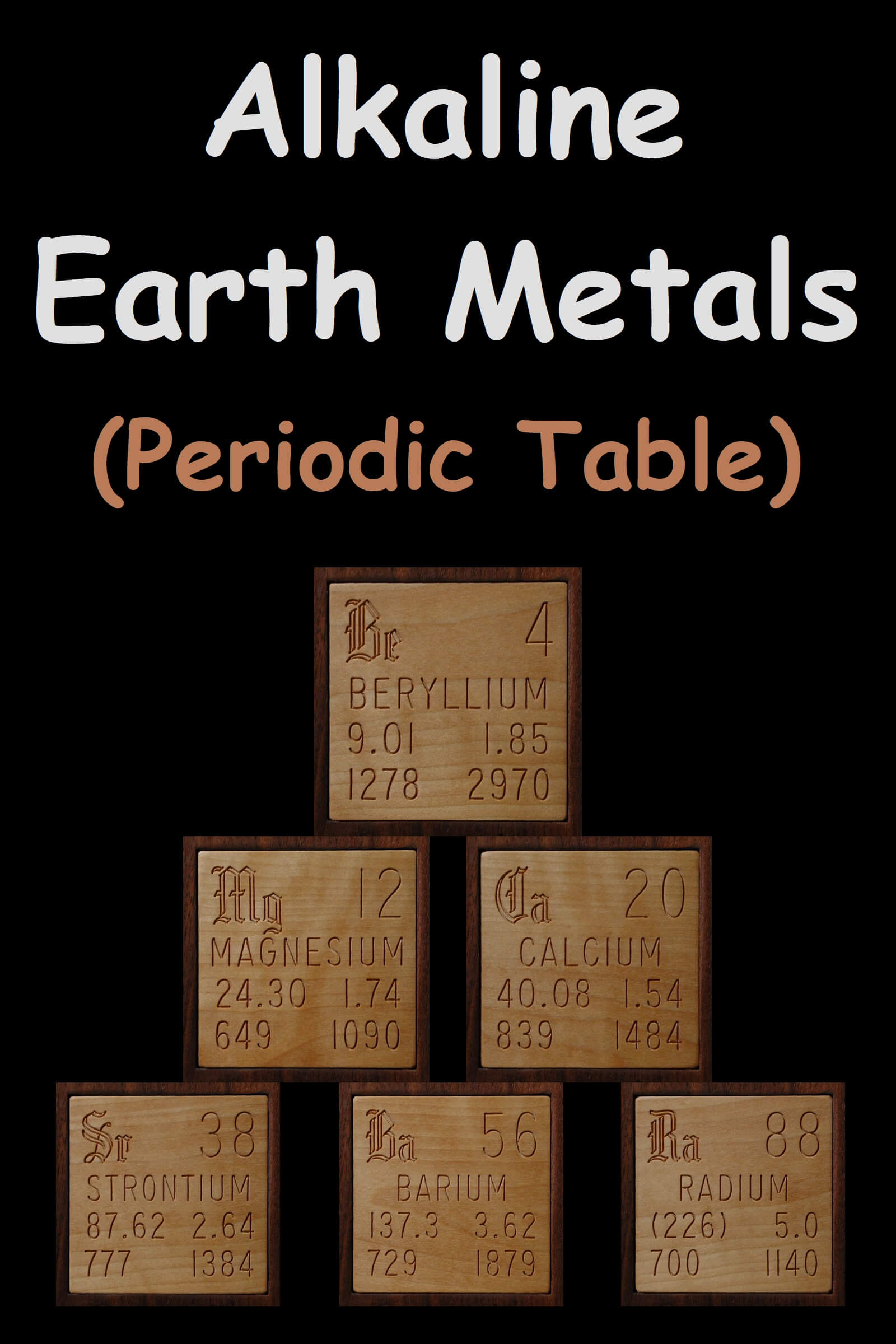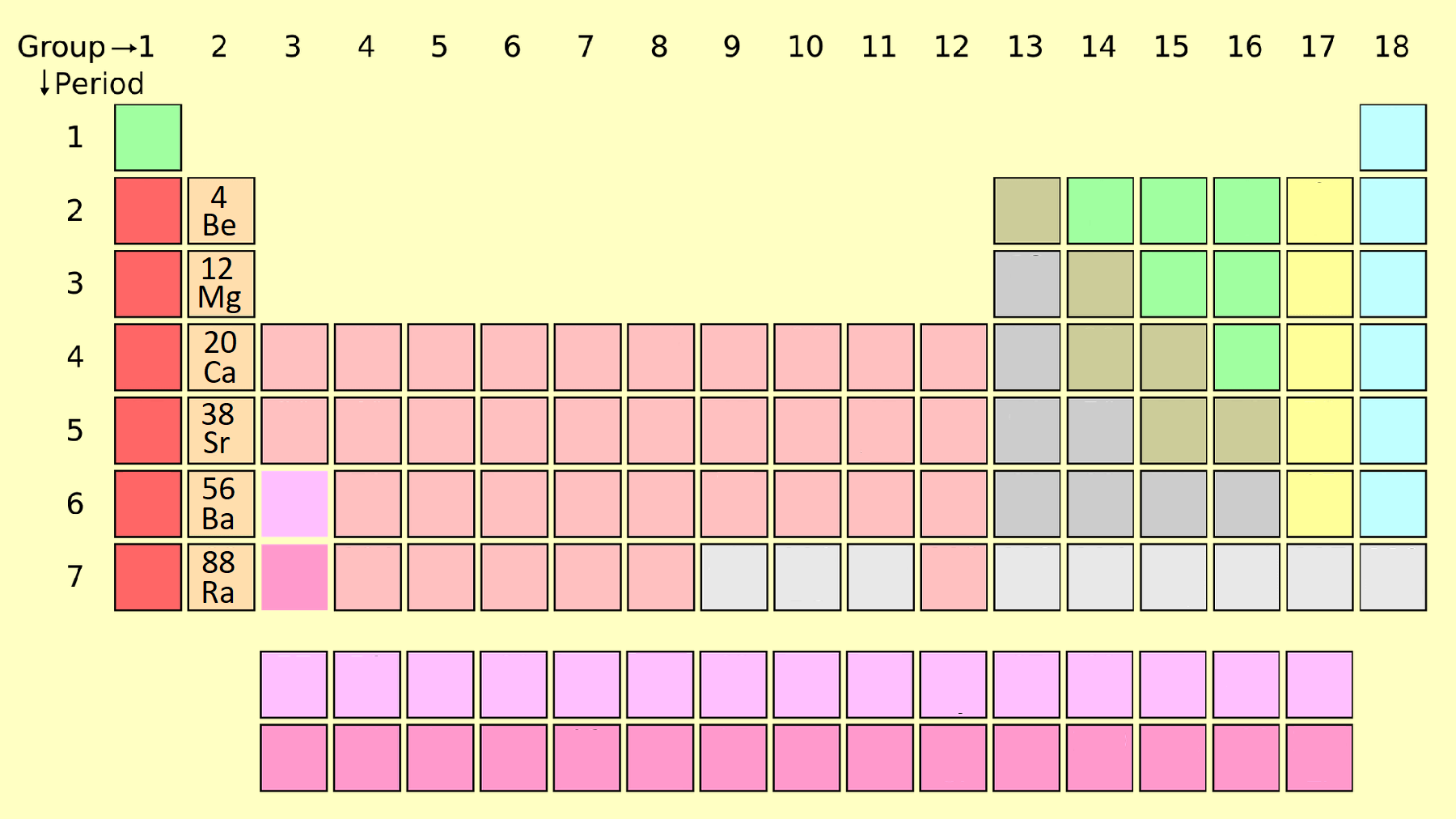Alkaline Earth Metals on Periodic Table
Alkaline earth metals (Be, Mg, Ca, Sr, Ba, Ra) are found in 2nd group of the periodic table. They are also known as alkali earth metals or alkaline soil metals. They are not found freely in nature. And they can easily lose their electrons and become positive ion, That’s why they are electropositive and ionic in nature. Let’s get to all know about Alkaline metals in details.
CONTENT INDEX
About Alkaline Earth Metals
- These metals are found in 2nd group and s-block of the periodic table.
- It consist of Beryllium, Magnesium, Calcium, Strontium, Barium and Radium.
- All of these metals have two electrons in their valence shell except beryllium, they can lose these valence electrons to form a doubly charged ion.
- With the exception of magnesium, these metals are stored in oil.
- To increase the atomic number, the names and symbols of six elements are: Beryllium (Be), Magnesium (Mg), Calcium (Ca), Strontium (Sr), Barium (Br), Radium (Ra).
Occurrence
- They are not found freely in nature.
- Alkaline metals occur in the earth’s crust but not in their original form.
Alkaline Earth Metal Properties
Some characteristics of alkaline earth metals are:
- Two electrons are present in their outer shell.
- They have +2 oxidation state which causes high reactivity.
- They are not found freely in nature.
- They show highly melting point.
- Alkaline metals have low density, low electron affinity and low electronegativity.
- They are silver in color, ductile in nature, and malleable.
- They react easily with the halogens and water.
Physical Properties of Alkaline Earth Metals
- These metals are generally silvery in color except Beryllium (Be) and Magnesium (Mg), Be and Mg are grey in color.
- They are harder than alkali metals.
- Ionization enthalpy increases as we go down to the group. They are strongly electropositive, for example: Be < Mg < Ca < Sr < Ba < Ra
- They show color property in flame test, as following: electron of Be and Mg are strongly bound. Ca-brick red, Sr-crimson, Ba-apple green.
- They are good conductor of heat and electricity.
- They show high melting and boiling point.
Chemical properties of Alkaline earth metals
Reactivity of alkaline earth metals:
They are less reactive than alkali metals. Their reactivity increases as we go down to the group.
1) Reactivity towards air and water: Be and Mg are inert towards oxygen and water, because of formation of oxide film on their surface.
- Be → BeO + Be3N2 (in the presence of air)
- Ca, Sr, Ba – they are readily form oxides and nitride in the air.
- Mg → MgO+ Be3N2 (in the presence of air)
- Alkaline earth metals +H2O → gives hydroxides (even in cold).
- Alkaline earth metals give hydroxides when they react with water.
2) Reactivity towards halogens: M + X2 → MX2 (X = F, Cl, Br, I) for preparation of BeCl2
Be+C+Cl2 ↔ BeCl2 + CO (600 – 800 K)
3) Reactivity towards hydrogen: M+H2 → MH2, when alkaline earth metals react with hydrogen, it will form metal hydride (Except Be).
2BeCl2 + LiAlH4 → 2BeH2+LiCl + AlCl3
When beryllium chloride (BeCl2) reacts with lithium aluminum hydride (LiAlH4), it will form hydride of beryllium. Here LiAlH4 is a strong reducing agent. It means that, it can easily remove hydrogen.
4) Reactivity towards Acids: Alkali earth metals react with acids and liberate hydrogen gas.
M+2HCl → MCl2 + H2
5) Reducing nature: They are also strong reducing agents (like alkali metals) but reducing power of these metals is less than alkali metals.
- Be is less strong reducing agent due to their large hydration energy and small size of Be2+
General Characteristics
These are general characteristics of alkaline earth metals and their forming compounds.
- Alkaline earth metals are less ionic than alkali earth metals due to their small size.
1) Oxides and hydroxides:
2M + O2 → 2MO (M= Be, Mg, Ca, Sr, Ba, Ra)
- All MO (Metal Oxide) have rock-salt like structure exception BeO (it is covalent).
- These oxides have high enthalpy of formation and stable to heat.
- Beryllium oxide (BeO) is amphoteric but other are ionic and basic and reacts with water to give hydroxides.
MO + H2O → M(OH)2
Stability, Solubility and basic character: Increases with increase in atomic number that is Mg(OH)2 to Ba(OH)2.
Alkaline earth metal hydroxides are less basic than alkali metals hydroxides (also less stable) due to their smaller size.
2) Halides
- Except Be all other halides are ionic in nature.
- BeX2 is soluble in organic solvents and covalent in nature. (X represent Halogens)
- Beryllium chloride (BeCl2) have chain like structure. And it dissociates at 1200k.
- Tendency to form halide hydrates decrease from MgCl.H2O to BaCl2.2H2O.
- Chlorides are more soluble than fluorides because of high lattice energy.
3) Salts of Oxoacids
i) Carbonates: They are insoluble in water.
- Solubility of carbonates are decreases with increasing in atomic number.
- All carbonates decomposed on heating to give CaCO3 → CaO + CO2
- Beryllium carbonate (BeCO3) is highly unstable (should be kept in atmosphere of CO2).
- Thermal stability increases with increase in size.
ii) Sulphates: All are white solid and stable to heat.
- Beryllium sulfate (BeSO4) and Magnesium sulfate (MgSO4) are soluble in water, And solubility is decreases from Be to Ba sulphates. (Greater hydration enthalpy causes solubility of Be and Mg).
iii) Nitrates:
MCO3 + 2HNO3 → M(NO3)2+ CO2+ H2O
- Metal nitrates tendency to form hydrates decreases with increase in atomic size.
- Mg (NO3)2.6H2O and Ba(NO3)2 (anhydrous)
2M(NO3)2 → 2MO + 4NO2 + O2
Uses of Alkaline Earth Metals
There are some uses of alkaline metals, Which are following:
- Be is used in alloys. (Cu – Be springs)
- Metallic Be used for making x-ray tube windows.
- Mg forms alloys with Al, Zn, Mn, Sn.
- Mg-Al form alloys used in air craft bodies.
- Mg (powder and ribbons) are used in flash powders, bulbs and crackers.
- Milk of magnesia (hydroxides) Mg(HO)3 used as antacid.
- Magnesium carbonate (MgCO3) used in toothpaste.
- Calcium used in reduction of metals.
- Calcium and barium create vacuum.
- Ra – salts are used in radiotherapy for cancer treatment.
Here is all the information about the alkaline earth metals. Now I hope you get the proper knowledge about alkaline earth metals, their occurrence, their physical and chemical properties and their uses. Here we have also discussed about their general characteristics and forming compounds. So, yes, we have covered all the information about alkaline earth metals.




